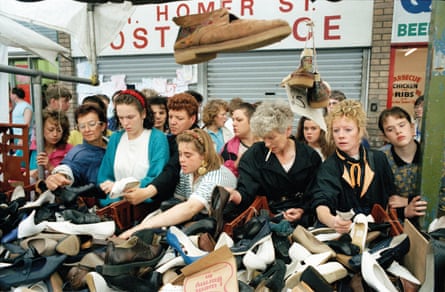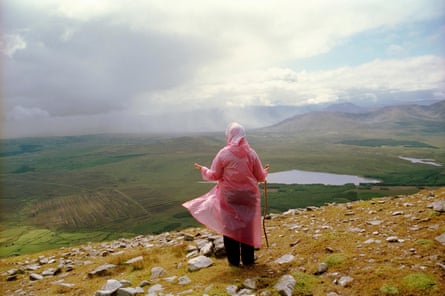Tom Wood likes talking. This is not just the exuberant conversation of a man excited at opening his largest-ever UK show. Talking to people and uncovering their stories is central to Wood’s 50-year-long practice. It is how he knows that the two ladies standing proudly in their gardens are called Mrs Leigh and Miss McCabe, and how the close knit, blue-eyed family at Seaview Cafe don’t get to see each other much because the dad doesn’t have many Saturdays off.
Wood started out in the 1970s with a degree in painting from Leicester Polytechnic, but he is known for his photographs of everyday life – many of which were captured in Liverpool and Merseyside during a period of huge social upheaval in the 80s and 90s. He chatted with people, agreed to photograph their weddings, took his camera on buses, to the shops, to football matches. Over his 25 years in Liverpool, Wood even attracted the affectionate nickname “Photie Man”, after which this exhibition is named.
Wood’s familiarity translates into his photography. There is no awkwardness here – only dignity and poise as his subjects stare boldly down the lens. In an early work from 1974, entitled Bird Wing Cape, a woman in a dark cape stands tall with her hair lifted slightly in the wind. Such is the power of her presence that it takes a moment to realise that two young children are dozing in a pram beneath her, and the contents of her home seem to be stashed behind her in the street.
At other times, Wood’s subjects stare straight past him. A picture shot in 1990 features women searching for shoes at the market. Only one of them spots Wood’s lens, the rest are engrossed in the search for a perfect pair. In a 1999 photo of match day, a group of men cross the road around Wood, while a young couple share a tender kiss.

Surprisingly for a man who has spent his life recording the world around him, Wood is a reluctant documentarian. He says in the exhibition notes: “I first wanted to take interesting images. The documentary aspect is to me a bonus.” His images are imbued with intrigue and oftenhumour; a child stands on the back of a cow, a baby has its nappy changed on a putting green, a young girl mimics her sunbathing mother, a sign on the door of a workshop in Cammell Laird shipyard reads: “I don’t know where Sammy is (try the shop).”
That is not to say Wood does not deal with serious subject matter in a respectful way, especially as he regularly focuses on people not traditionally represented in the media – whether that be elderly women in smoking rooms, teenage lads leaning on railings or mothers hauling babes and bags round markets. In a particularly sensitive series from 1988, Wood captures patients at Rainhill psychiatric hospital. Wood was due to spend just six weeks there, but eventually spent two years visiting the patients. A standout image depicts a man standing centrally in a communal lounge, a ray of sunlight shines down on him and smoke from his cigarette fills the air. He is dressed smartly and stares straight at us, an affirmation of his existence despite being hidden away behind the hospital walls.

There are a lot of photographs in the exhibition – including vintage postcards Wood collected as a youth – and at times it feels hard to keep up; the show begins chronologically but then hops between being location- and theme-driven. There are also two video works, an assortment of cameras, snippets of poetry and a display of photobooks, which is all interesting, but cannot compete with the pure, quiet joy of standing and staring at Wood’s handprinted photographs.
At the end of the gallery is an iPad where people can sign up to say if they appear in any of the photographs and to share their stories. Wood is eager to reconnect with many of his previous subjects, and as I leave, I hear a woman telling Wood that her aunt is in one of his images. And so the talking goes on.

